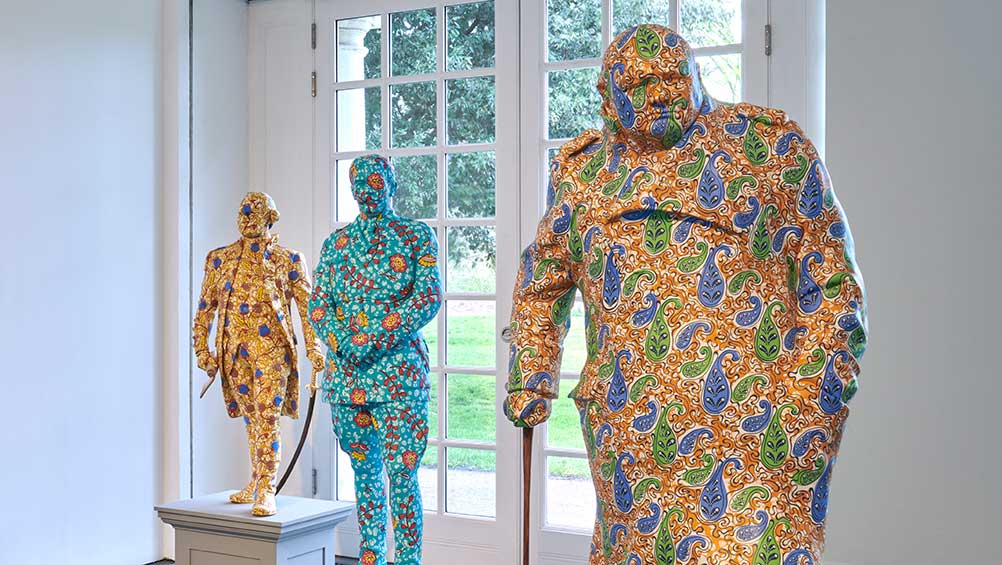
Decolonised Structures (Sir Winston Churchill in foreground), Installation view, Yinka Shonibare CBE: Suspended States, Serpentine South, 2024. © Yinka Shonibare CBE 2024. Photo: © Jo Underhill. Courtesy Yinka Shonibare CBE and Serpentine.
Serpentine South, London
12 April – 1 September 2024
by VERONICA SIMPSON
There is a value in recognisability; the pull and punch of the familiar trope can speak volumes in the right setting. And Yinka Shonibare’s signature use of the exuberant colours and patterns of west African batik print has had its moments. For example, it offered a deliciously angry counterpoint in the recent Royal Academy Entangled Pasts show: wrapped around a life-sized African woman, bent double and scrubbing at some ornate, embellished steps, in a room filled with Arcadian visions of 18th-century tropical landscapes and mansions, commissioned by sugar plantation owners. In this setting, as well as on the sails of a military sailing boat shoved into a bottle, for Shonibare’s triumphant Fourth Plinth commission in Trafalgar Square (Nelson’s Ship in a Bottle, 2010), this print becomes a vivid and violent reminder of those who were worst impacted by Europe’s big, colonial project – especially as the print’s connection to our trading histories is so layered: Indonesian-inspired batik exported to west Africa by the Dutch; it does indeed serve “as a symbol for the intricate ties between Europe and Africa,” as the introductory leaflet for this show attests.
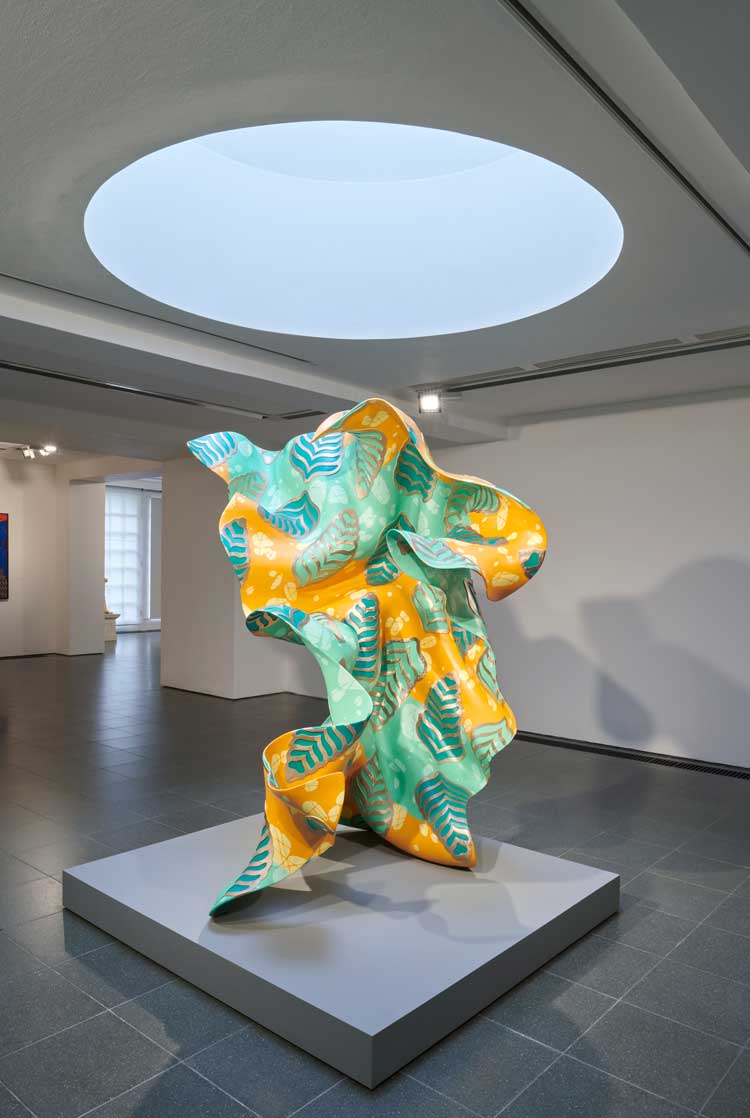
Wind Sculpture in Bronze IV, 2024. Installation view, Yinka Shonibare CBE: Suspended States, Serpentine South, 2024. © Yinka Shonibare CBE 2024. Photo: © Jo Underhill. Courtesy Yinka Shonibare CBE and Serpentine.
But familiar tropes can become tired when overused, as in this, Shonibare’s first major exhibition in a London gallery for more than 20 years. There is a billowing bronze sculpture painted in ebullient hues and forms at the entrance, which doesn’t say much other than: “Here’s a new medium and form for Shonibare’s trademark pattern and palette (Wind Sculpture in Bronze IV, 2024).” Beyond that is a room filled with familiar public statues of celebrities of the old, aristocratic orders, for his series Decolonised Structures (2022-23); soldiers, queens and kings are also covered in eye-popping varieties of that trademark bright, botanical print. But the instant I encountered the accumulated mass of these flamboyantly clad statues I felt the joke fall flat; they amount to less than the sum of their parts.
Some of these statues are instantly recognisable – Queen Victoria, Winston Churchill. Others less so - Clive of India, Lord Kitchener, Ivor Roberts-Jones – but we get the point. These are the people to whom, up until very recently, the British loved to build monuments, thanks to their imperial or military achievements, overlooking those who were trampled in their wake or who fell in support of their endeavours. But it’s rather simplistic to suggest that merely wrapping them up in a flamboyant print “decolonises” them. For the most part, it gives them a rather jaunty new look.
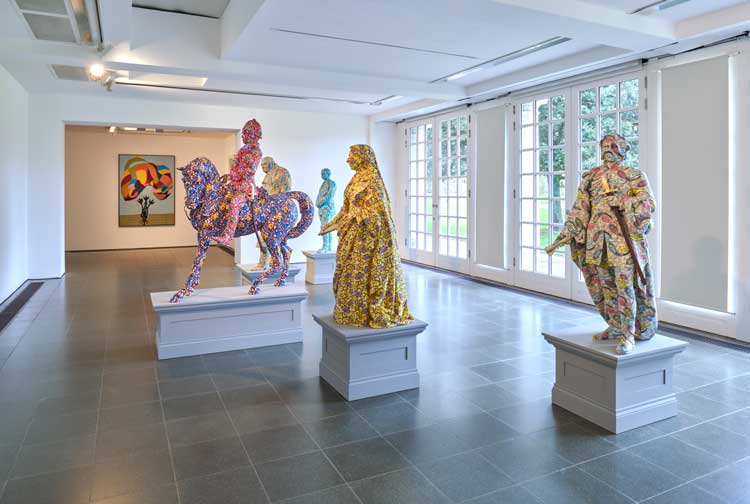
Installation view, Yinka Shonibare CBE: Suspended States, Serpentine South, 2024. © Yinka Shonibare CBE 2024. Photo: © Jo Underhill. Courtesy Yinka Shonibare CBE and Serpentine.
Unstructured Icons (2018) continues in the same vein but in two dimensions: prints of famous characters taken from portraits we recognise by famous painters, from Pope Innocent X (by Velázquez) to Henry VIII.
The batik trope has more impact at scale, perhaps, in the library Shonibare has created in one room (The War Library, 2024), lining the walls with more than 5,000 volumes of pretend books, each one spelling out in gold lettering along its spine the name of a significant conflict or peace treaty, and bound in the trademark fabric. There is clearly some deep research underlying this work: you would be duly horrified if you looked up the Fulani war in Nigeria and Cameroon of the 19th century or some of the biblical genocides referenced. But these books are not for reading – they can’t be removed from the shelf. And I was less impressed when I learned that this is one of a series of identical (apart from the names on the spines) libraries Shonibare has created, including also The British Library (2014), The American Library and The African Library (both 2018).
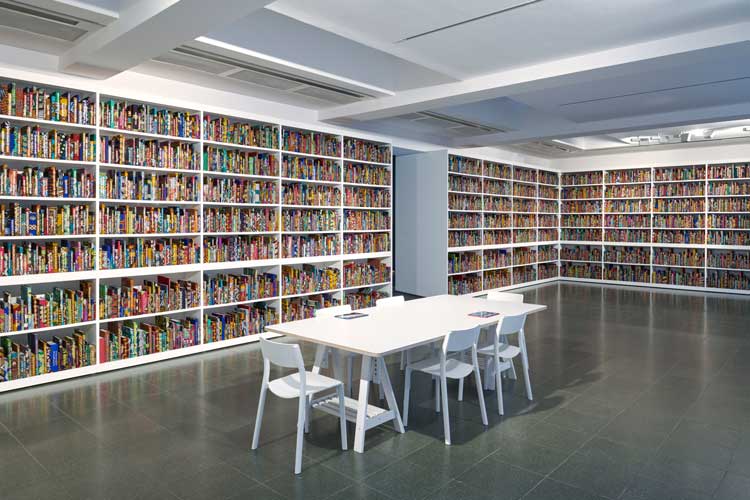
The War Library. Installation view, Yinka Shonibare CBE: Suspended States, Serpentine South, 2024. © Yinka Shonibare CBE 2024. Photo: © Jo Underhill. Courtesy Yinka Shonibare CBE and Serpentine.
The sound of Shonibare’s voice in the background draws us to a genuinely heart-warming film that demonstrates the extraordinary generosity and philanthropy of this artist, detailing his Guest Artists Space (GAS) Foundation in Lagos and Ijebu, and the Hackney version, Guest Projects, which kickstarted the programme back in 2008, offering free studio space to up-and-coming artists. Shonibare has done good things with his increasingly lucrative artist earnings, which is one of the reasons he was awarded a Commander of the British Empire (CBE), a title he includes in his name now “as a gesture towards his complex relationship to British honours and the systems they represent” (says the leaflet). Nobody can doubt Shonibare’s intentions and the importance of his contribution to date, but doesn’t anyone else out there agree that a truly great artist is one who continues to interrogate and prod, provoke and expand, engaging us in new ways, thanks to their ongoing curiosity and the evolution of their practice?
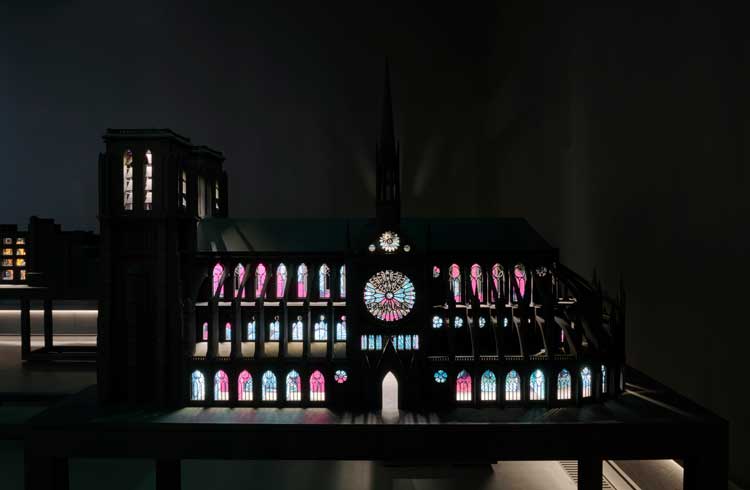
Sanctuary City, installation view, Yinka Shonibare CBE: Suspended States, Serpentine South, 2024. © Yinka Shonibare CBE 2024. Photo: © Jo Underhill. Courtesy Yinka Shonibare CBE and Serpentine.
We are offered one interesting evolution in a room full of models. Sanctuary City (2024) presents 17 small replicas of significant buildings, each external elevation painted in black. Some are famous structures – Notre-Dame de Paris, the UN headquarters in New York, the Temple of Hephaestus in Athens, or the Cathedral of Saint Elijah in Aleppo – and others less so. The mood in this black-walled, darkened space is captivating, with each model providing the only illumination, from within, to draw our attention to the batik prints lining each interior. I thought this room was beginning to say something interesting and different, in that all of these structures were built to offer sanctuary, but each has also been the site of atrocities. Is the repeated application of the same trope and materials this time rendered more powerful or weaker? I’m not sure.
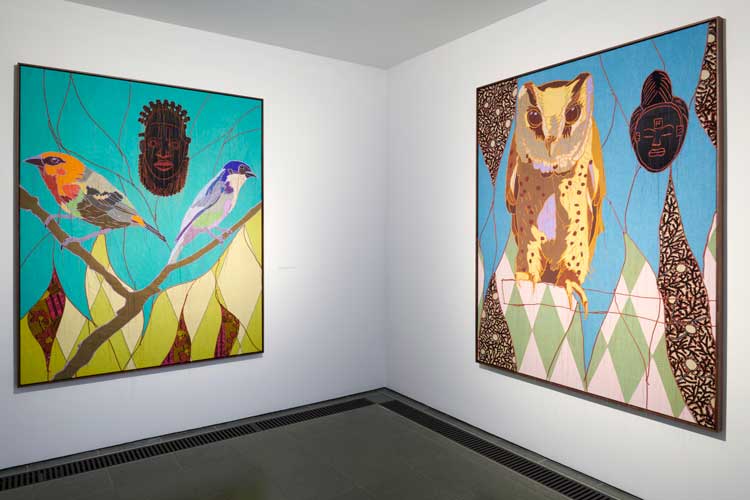
African Bird Magic (2023) quilt series, installation view, Yinka Shonibare CBE: Suspended States, Serpentine South, 2024. © Yinka Shonibare CBE 2024. Photo: © Jo Underhill. Courtesy Yinka Shonibare CBE and Serpentine.
There is a new African Bird Magic (2023) quilt series, where endangered birds such as the Sokoke scops owl or Mauritius fody are portrayed in their own vivid plumage, all of them endangered by colonialism and the widespread industrialisation of their habitats that has followed. Each quilt design features an African mask, which Shonibare sees as “symbols of African empowerment to challenge the consequences of western colonial industrialisation in the degradation of the African environment” (says the leaflet). He has snuck a few strategic slivers of batik print into the margins of these quilts – lest you forget that this is a true Shonibare – but the overall compositions, while attractive enough, don’t quite lift themselves beyond the decorative.
Born in London in 1962 and raised between London and Lagos, Shonibare became a rising star of the 1980s art world, along with Goldsmiths stablemates Damien Hirst and Sarah Lucas. They too have made themselves rich through the repetition of the daring, at times brilliant tropes with which they made their names – and, in Hirst’s case, a few more tropes he invented subsequently. But I find their reliance on these early tropes just as disappointing (especially Lucas’s recent Tate Britain retrospective, where the endless variations of her visual gags riffing on boobs, bums and willies, when replicated over four or five decades, in five or six galleries, albeit with different materials, simply ended up seeming both tired and sad). When that early brilliance and inventiveness ends up being co-opted in the name of commerce, I don’t call that art so much as branding.